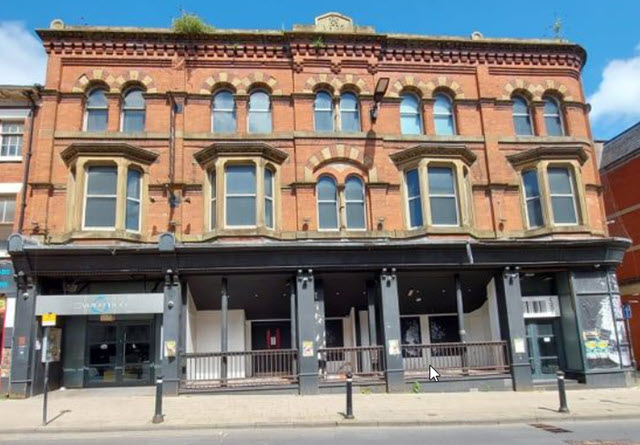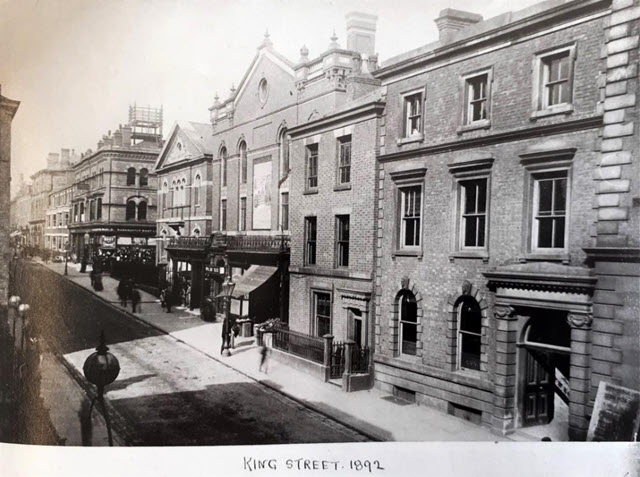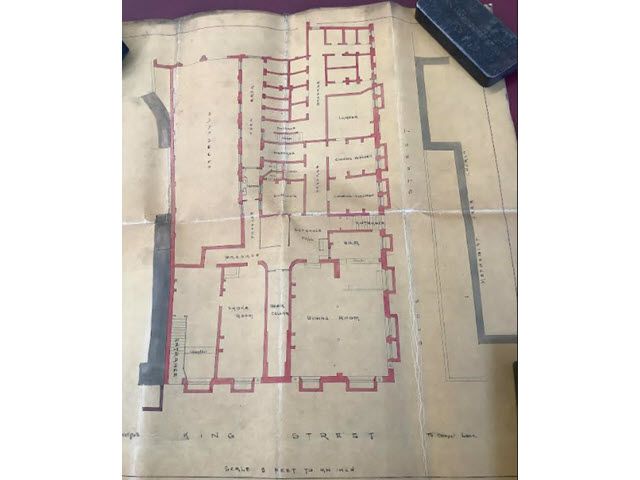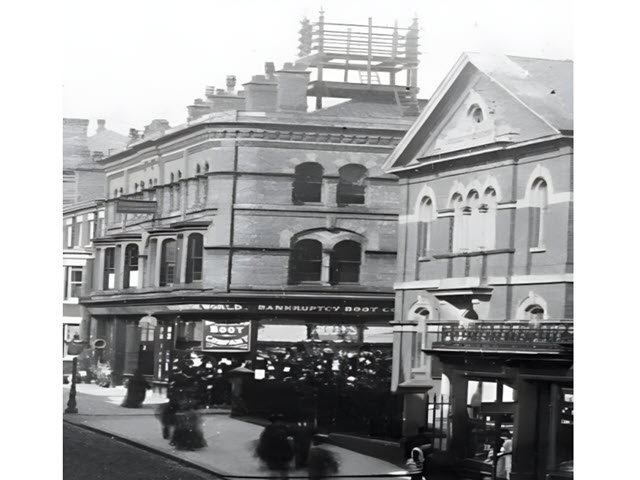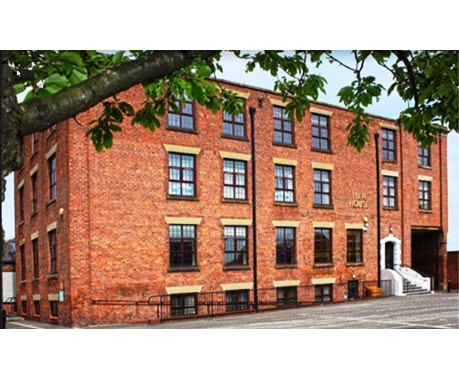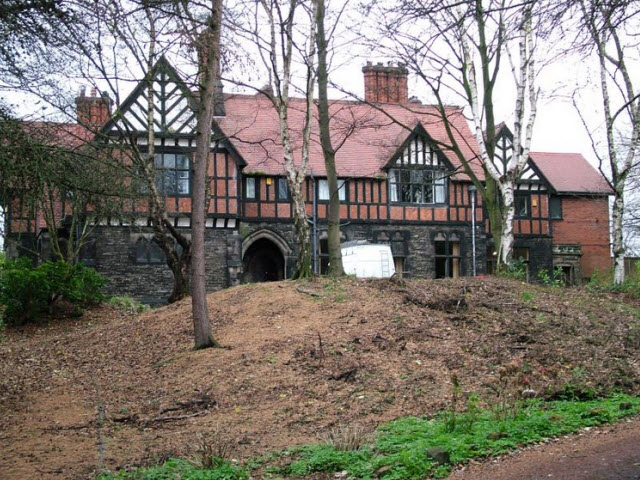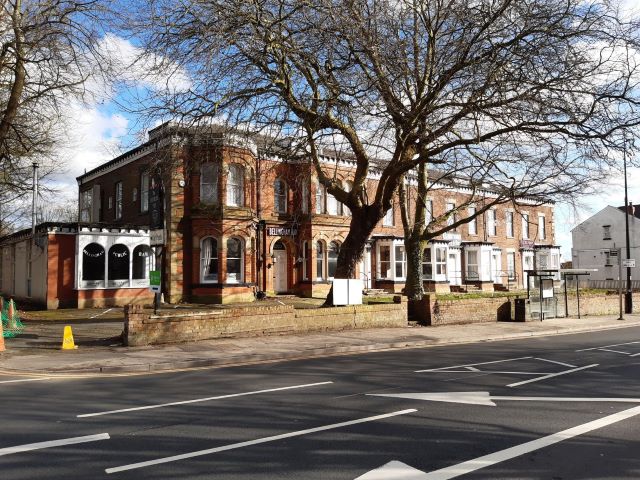Victoria Buildings
36 - 44 King Street, Wigan, Wigan
Part of Group:
At Risk: No
Description
The Victoria building was commissioned by James Whitfield, an Ironmonger who owned Clarington Brook Forge and Iron Foundry, later becoming Bulldog Tools. and designed by Architect Mr. George Heaton (born in Pemberton 1831 – 1899).
It is situated between 36-44 King Street with the corner of College Avenue in Wigan. It lies within the Wigan Town Centre Conservation Area although it is not a listed building. A planning application was approved by Wigan Council on 17 May 1876 for a commercial property with a basement and three floors above. It was built by James Fairclough’s company, bricklayer Mr John Johnson and plasterer Mr. Mooreby. (referenced in a newspaper article of 1877 celebrating the opening).
The original building had two shops on either side of the central main entrance. The central door gave access to the basement and smaller offices above and was three storeys in height. As it stands today, you can just make out the four bays on the first floor with a central window which would have stood above the original entrance.
The building was formally opened on 15 September 1877. initially, James Whitfield transferred his ironmongering business into the new building. Later the same year adverts can be found in local newspapers for Butter and Bacon Markets.
Occupants
Over the years many professions came and went from the building including Professional Surveyors, Architects, Civil Engineers, Accountants, Insurance Companies, stock and sharebrokers, and shop owners. One consistent was food and entertainment trades. There have been several bars, restaurants, and more recently night clubs in the building up until 2021. It is currently up for refurbishment into residential accommodation.
Census data between 1881 and 1939 show very little residential use of the building, see link.
Telephone Exchange – see separate document.
Restaurants
In the same year the Victoria Restaurant was opened in the basement, recorded by the Wigan Observer and District Advertiser (WODA) in November 1878 as the first public restaurant in Wigan. This soon changed its name to Horder’s restaurant, offering private dining room for ladies.
Later in 1880 it was advertised as being under new management by Mrs A Leyland the then Victoria Restaurant was to be known as the Wigan Restaurant Company. Four years later in 1884 an advert appeared giving details of the winding up of the Wigan Restaurant Company.
In 1888 the Victoria restaurant reopened. (Wigan Almanac, Mar 15, 1888) Before changing the name again to The Garrick in 1891. The census of that year recorded Rachel E Burrows and Elizabeth Thomas as waitresses.
During 1895 the Manager and Beer seller Mr William Harrison was found to have people in his licensed premises who did not live there, he was charged with the unlawful sale of intoxicating liquor.
During September 1899 the landlord of the Garrick Restaurant in the basement – Mr Hall applied for permission to change their name from Victoria restaurant to the Garrick and permission to make some internal alterations. (WODA 30 Sept 1899). They proposed turning a large part of the building into high class luncheon bar.
The planned alterations went ahead in November 1899 making an entry from College Avenue.
By 1903 the restaurant was owned by Mr Llewelyn, this changed again by 1913. The resident manager had been transferred from David Henry Bearden to Mr JW Alder.
Bodega Bar and Cafe
Alfred Silvester was the licence holder form 1903. In 1905 a dinner was held for the Wigan Polo team relating to new baths to be opened in Wigan. With an after-dinner concert being held at the Orange Hall, King Street.
Several changes were requested to make alterations to the building from November 1909, some were refused. There was a transfer of licence from Mr David Henry Bearden (Sec) to Mr J. Alder who would be resident manager during 1913. This later transferred to Mr Alfred Silvester, the 1901 and 1911 censuses show him living at 28 King Street with his wife Rosa Ann and children. He died in 1917 age 50. His wife continued to manage the bar for several years. In 1924 it changed names again to the Bodega Co. Ltd. Wine Merchants.
From around 1983 the names changed again, first it became the Bier Kellar, then merged with the Transport Club and became the King of Clubs, exact dates not known.
One confusing aspect of the whole research of King Street has been the discrepancies with house numbers over the 200 years.
Shops
Shops on either side of the entrance to the Victoria Building again saw many occupants. Some longer serving occupants are noted below.
A shop selling Bicycles, Tricycles, Bassinets and Mail Carts between 1891 and 1920’s was managed by Mr HH Timberlakes. In 1924 adverts can be found for Automobile engines.
During the same period, Smith’s Bicycles had moved from number 16 to number 30. Mr J. Smith and Sons – selling bicycles and then pianos, advertised in 1893 as the best and cheapest house in Wigan for hiring pianos and organs. On the same newspaper page, they advertised sales of old and new violins, harps, guitars, Banjos, flutes, clarinets, and concertinas along with all kinds of strings and fittings. Advert in 1904, June stated, “Smiths are without doubt Agents for the World’s best Bicycles” By 1910 Smiths were advertising the sale of bicycles, tyres, lamps, bells pumps etc. (WODA 16 April 1910).
In May 1923 two adverts can be found on the same page for Timberlake’s and Smith’s Bicycles.
Emmanuelle Vitali (1862- 1934, born at Lake Como Italy) recorded as a fine art dealer in the 1891 with a shop in Pemberton, this was scheduled for demolition in 1894 when he moved to King Street. A few years later in 1895 Kelly’s Directory shows him as a Picture Framer based at 30 King Street.
Newspaper advertisements in 1906 and 1907 recorded Mr Vitali, Picture Frame Makers, wholesale, retail catholic repository. Best and cheapest place in town. Door on the right inside the building from King Street main entrance. (Advert WODA December 1906 and May 1907).
Another familiar name for many years in King Street was Mr William Ollerenshaw, (1843-1929) a Hatter and Hosier at number 32. Advertising in the 1881 Wigan trade directory as a Practical Hatter and Gents outfitter, oldest established in Wigan. During 1890 he was advertising new shapes in silk and felt hats. In 1909 he was recorded as a hat manufacturer (advert in WODA).
Many adverts in the local newspaper show the variation of trades based in Victoria buildings, for examples see listed below.
- Bankruptcy Boot Company, selling boots and shoes, advert in WODA on 26 December 1891
- Eureka shop sales – cook ware.
- · 1913-14 advert in WODA for Kimoc Medicine specialist and experts located at 34 King Street (Advert in WODA 20 December 1913, page 8 and WODA 3 January 1914 page 4))
- · 1916 new Gas showroom opens – WODA March 4, 1916.
- · Hiltons Boot Shop, on corner of Victoria Building as seen in photograph from 1892 which also shows the observation tower on the roof.
- · Hiltons Booteries advert for staff 1900 – Blackpool Pawnbrokers Auction Sale advertised March 1910 at Late Hiltons Boot shop.
Between 1978 and present day, several planning requests were made for change of use, also structural changes and movement of doorways, see timeline. There were also several name changes of nightclubs also noted Leo’s Barn – 1979, Liquid Nightclub 2005-2011, Elements 2012, Evolution 2016 to 2020.
In 2021 an application was made for a further change of use of the building residential. This due to start in 2023/4.
It is unclear how many offices or shops were available over the last two hundred years in the Victoria building, the timeline names many of them taken from various sources.
Another services worthy of note were:
Wigan School Board – accessed by the side door entrance on College Avenue outline of the door is still visible although fully blocked in. School boards were public bodies in England and Wales between 1870 and 1902, which established and administered elementary schools.
The first Wigan School Board meeting was held in Victoria Building in 1878, presided Mr France, Present were Messrs. JM McClure, W Berry, J Hill and Mr Lever Robert Rowbottom, Esq. was clerk to the Wigan School Board at the time. (WODA 11 Oct 1878)
School boards were created in boroughs and parishes under the Elementary Education Act 1870 following campaigning by George Dixon, Joseph Chamberlain and the National Education League for elementary education free from Anglican doctrine. Education was still not free of fees. Members were directly elected, not appointed by borough councils or parishes. Each board could:
- · raise funds from a rate
- · build and run non-denominational schools where existing voluntary provision was inadequate
- · subsidise church schools where appropriate
- · pay the fees of the poorest children
- · if they deemed it necessary, create a by-law making attendance compulsory between ages 5–13 - until the Elementary Education Act 1880 when it became compulsory for all.
- · not to impose any religious education, other than simple Bible reading.
Unusually for the time, women were eligible to win election to school boards. When the first elections were held, in 1870, seven women were elected across the country: Anne Ashworth and Caroline Shum in Bath, Catherine Ricketts in Brighton, Lydia Becker in Manchester, Marian Huth in Huddersfield, Eleanor Smith in Oxford, and Jennetta Temple in Exeter.
Members of Wigan School board were appointed by the Town Council following a letter from Education department Privy council in March 1872. Eleven members elected without contest and representatives of each denomination as an amicable arrangement.
They met monthly at Wigan Borough courts on Rodney Street until July 1878 when they met in the new Victoria Building offices. Last meeting was held in September 1903.
Wigan Rural District Council
Also based in Victoria Building; specific dates are unknown. The Wigan Rural Sanitary Authority was set up in 1872 under the Public Health Act (1872) following application by the Wigan Board of Guardians. It took in the townships of Dalton, Haigh, Parbold, Shevington, Worthington and Wrightington. It was later superseded by a Rural District Council covering the same area, the first meeting of the Council was held in December 1894.
Offices of the Clerks to the Board of Guardians
The Wigan Poor Law Union officially came into existence on 2 February 1837. Its operation was overseen by an elected Board of Guardians, 28 in number, representing its 20 constituent parishes and townships. The population falling within the Union at the 1831 census had been 58,402with parishes ranging from 124 to 20,774 in Wigan itself.
The new Wigan Union Workhouse in Frog Lane was built by a local firm James Fairclough and son. The foundation stone was laid in April 1856 and was opened in December 1857.
The Board of Guardians held their first meeting in their new board room at Frog Lane on Friday 5 March 1858. Later offices could be found in both Victoria building and Leader’s building on King Street. Two of the towns prominent people, Mr Henry Ackerley then Mr H Gordon Ackerley, spent a few years as Clerks to the Board of Guardians.
The last Chairman, appointed at the meeting on Friday 19 April 1929 was Gordon McGregor Esq. Following the Local Government Act of 1929, the Wigan Board of Guardians was abolished on 1 April 1930, and responsibility was passed to Wigan Corporation. After three hundred years Wigan Workhouse had finally been consigned to history
Wigan Coroners Office
Several Wigan coroners were based in Victoria building before moving across the road to the Leaders building. Several prominent gentlemen, whose names who appear in various roles over the decades held the post of Coroner for the Town.
In 1912 Mr H Milligan, 1916 Mr Harry Milligan, only son Mr Frank Russell Milligan granted a commission in the 20th Kings Liverpool regiment in 1915. He died in August 1917 in Southport, having been articled to Mr Maskell W. Peace, Solicitor who he succeeded in coronership fifteen years before. Past member of Holmes Lodge Wigan of Freemasons.
On 1 September 1917 the new Wigan Borough Coroner Mr John Hopwood Sayer. (Born 24 October 1888, son of Mr John Sayer, veterinary surgeon of Standish. Married Kathleen N Smith in 1947, Ince and Died 14 April 1975 in Glebe House, New Market Street, Wigan). He attended Wigan Grammar School, then Rossall School. Articled with Mr Harold Devon’s, former Town Clerk of Wigan and admitted as a Solicitor in March 1912. Became deputy to late Coroner in December 1913, comes from an old Wigan family, great grandfather John Hopwood had been Mayor twice in 1809 and 1812. Grandfather Richard Fogg Hopwood was also Mayor in 1881
In August 1918 Mr J Hopwood Sayer held first inquest without a jury, following the passing of the Jury’s act which allowed Coroners to dispense altogether with juries. Still serving in 1968 he was the longest serving Coroner in the Country.
The town Coroner in 1930 was Mr A. J. Johnson, JP and held the role of deputy Borough Coroner for Wigan was injured in a motor car incident in Park View Wigan.
The Wigan Mission of Apostolic church also known as Catholic Apostolic Church, was listed in Kelly’s Directory as being at Victoria Buildings, King Street Wigan between 1891 and 1918. Although registration as a place of public worship and for the solemnization of marriages was considered in 1903, this was probably never affected.
A baptismal register was kept but does not survive. (Wigan Archives, minutes and register of services D/NCa Ap, 2 files, Acc. 1859.)
Jan Bannister Thomas

